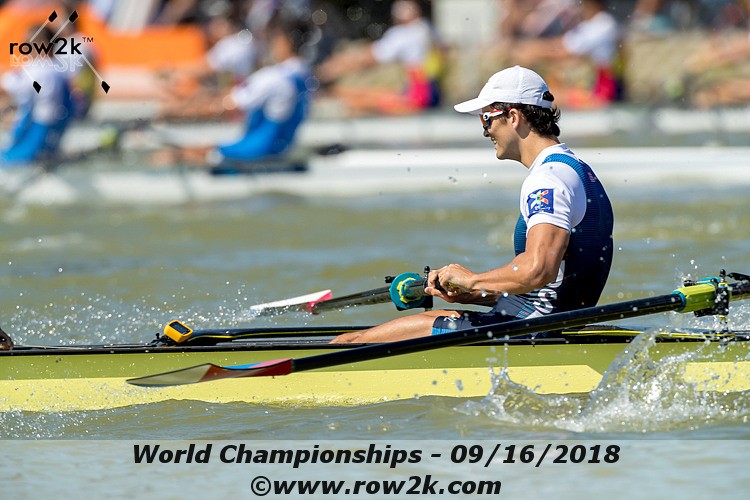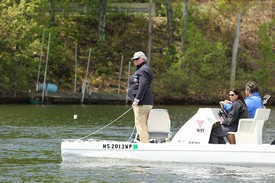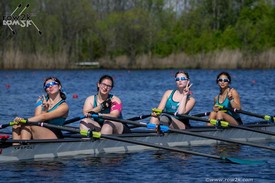Charlotte Hollings, Calm Waters Rowing

As the sport of rowing continues to grow, we have the opportunity to coach many people who are just beginning their rowing career. Most of these are adults who have taken a "learn to row" class at their club. If they enjoy the sport, they often come to us to learn more quickly and make improvements that prepare them to row with more experienced rowers back home. In most cases, they were taught in eights with perhaps an experienced club member volunteering to run the class. The coach's goal is mainly to give their charges a taste of the sport, get them out in boats, teach a few basics, and let them see if they like it.

Since the rowing stroke consists primarily of three parts – arms, back and legs – that is often the way it is taught. Push the legs, pivot the body, pull the arms for the drive; and then arms away, body over, ride up the slide for the recovery. In other words, legs, back, arms, arms, body, legs. At the same time, they’re told to sit tall and maintain good posture. The difficulty with all this is that it often becomes very mechanical and is reinforced with drills such as arms only or pausing with body over and knees down. It's easy to teach it this way, but when reinforced, it gets away from the true essence of the sport, the fluidity of motion that needs to be attained to really make the boat move.

Rowing is a dynamic sport. We are looking for motion. The boat is moving through water, a liquid. Water is flat, so only forces in the horizontal plane are going to move the boat forward. Any forces in the vertical plane will cause the boat to lift and then sink and are therefore wasted.
So what would we teach on day one of the "learn to row" class? The rowing motion should contain three elements: 1) horizontal 2) relaxed and 3) fluid. We do this not by sitting up but by staying relaxed and low with the head held horizontal. We emphasize that the arms are the connecting link between the body and the oar and that connection is made through the lat muscle primarily, not the shoulders. We teach that the body motion is more important than the arms so arms away is wasted time and effort, instead we teach the body pushes the arms. Trying to hold the legs down until the oar handle is over the shins just makes one stiff, so we keep the knees soft and never lock the legs down. The knees can begin to come up as soon as the oar reaches the knees and now the body movement out of bow can very easily move into the slide, creating a more fluid motion. As for the catch, a loose muscle is infinitely more responsive than a tight muscle, so keep the arms loose and let them make the catch, not the body. A loose arm can do that much more efficiently than a straight, tight arm.

Obviously there are many more details that could be included and the details are important, but on Day 1, there’s not enough time to go into all that. What can be taught is the natural fluidity, relaxation and horizontal motion of the stroke. Sitting tall, getting quick arms away, holding the knees down – none of that will get you there. Make rowing relaxed and simple... and then it will be more fun as well!

If you enjoy and rely on row2k, we need your help to be able to keep doing all this. Though row2k sometimes looks like a big, outside-funded operation, it mainly runs on enthusiasm and grit. Help us keep it coming, thank you! Learn more.
Comments | Log in to comment |
- Bont Rowing
- Calm Waters Rowing
- Concept 2
- Craftsbury Sculling
- The Crew Classic
- CrewLAB
- Croker
- Dad Vail Regatta
- Durham Boat Co.
- Empacher
- Faster Masters
- Filippi
- Fluidesign
- h2row.net
- HUDSON
- Live2Row Studios
- Nielsen-Kellerman
- Oak Ridge RA
- Peinert Boat Works
- Pocock Racing Shells
- Race1 USA
- Rockland Rowing Masters Regatta
- RowKraft
- Rubini Jewelers
- Vespoli USA
- WinTech Racing
- Bont Rowing
- Calm Waters Rowing
- Concept 2
- Craftsbury Sculling
- The Crew Classic
- CrewLAB
- Croker
- Dad Vail Regatta
- Durham Boat Co.
- Empacher
- Faster Masters
- Filippi
- Fluidesign
- h2row.net
- HUDSON
- Live2Row Studios
- Nielsen-Kellerman
- Oak Ridge RA
- Peinert Boat Works
- Pocock Racing Shells
- Race1 USA
- Rockland Rowing Masters Regatta
- RowKraft
- Rubini Jewelers
- Vespoli USA
- WinTech Racing

















03/13/2019 2:41:19 PM
01/09/2019 5:50:13 PM
01/07/2019 12:03:52 PM
01/16/2019 11:16:36 PM